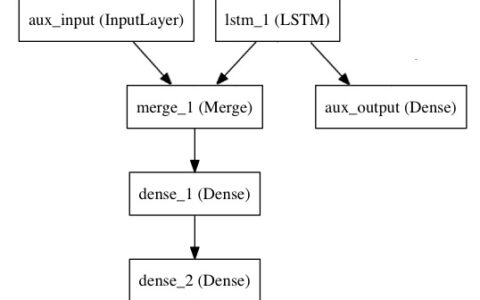下面是关于“Keras自定义loss model.add_loss的使用详解”的完整攻略。
Keras自定义loss model.add_loss的使用详解
在Keras中,我们可以使用model.add_loss()函数来添加自定义的loss函数。这个函数可以帮助我们实现更加复杂的loss函数,从而提高模型的性能。下面是两个示例说明,展示如何使用model.add_loss()函数。
示例1:添加自定义的loss函数
import tensorflow as tf
from keras.models import Model
from keras.layers import Input, Dense
# 定义模型
inputs = Input(shape=(10,))
x = Dense(64, activation='relu')(inputs)
x = Dense(64, activation='relu')(x)
predictions = Dense(1, activation='sigmoid')(x)
model = Model(inputs=inputs, outputs=predictions)
# 定义自定义的loss函数
def custom_loss(y_true, y_pred):
return tf.reduce_mean(tf.square(y_true - y_pred))
# 添加自定义的loss函数
model.add_loss(custom_loss)
# 编译模型
model.compile(optimizer='rmsprop', loss=None)
# 训练模型
model.fit(x_train, y_train, epochs=10, batch_size=32)
在这个示例中,我们定义了一个自定义的loss函数custom_loss。我们使用tf.reduce_mean()函数计算平方误差。我们使用model.add_loss()函数将自定义的loss函数添加到模型中。我们使用compile()函数编译模型。我们使用fit()函数训练模型。
示例2:添加多个loss函数
import tensorflow as tf
from keras.models import Model
from keras.layers import Input, Dense
# 定义模型
inputs = Input(shape=(10,))
x = Dense(64, activation='relu')(inputs)
x = Dense(64, activation='relu')(x)
predictions = Dense(1, activation='sigmoid')(x)
model = Model(inputs=inputs, outputs=predictions)
# 定义自定义的loss函数
def custom_loss(y_true, y_pred):
return tf.reduce_mean(tf.square(y_true - y_pred))
# 添加多个loss函数
model.add_loss(custom_loss)
model.add_loss(custom_loss)
# 编译模型
model.compile(optimizer='rmsprop', loss=None)
# 训练模型
model.fit(x_train, y_train, epochs=10, batch_size=32)
在这个示例中,我们定义了一个自定义的loss函数custom_loss。我们使用tf.reduce_mean()函数计算平方误差。我们使用model.add_loss()函数将自定义的loss函数添加到模型中。我们添加了两个相同的loss函数。我们使用compile()函数编译模型。我们使用fit()函数训练模型。
总结
在Keras中,我们可以使用model.add_loss()函数来添加自定义的loss函数。我们可以使用tf.reduce_mean()函数计算平方误差。我们可以添加多个loss函数。我们可以使用compile()函数编译模型。我们可以使用fit()函数训练模型。
本站文章如无特殊说明,均为本站原创,如若转载,请注明出处:keras 自定义loss model.add_loss的使用详解 - Python技术站

 微信扫一扫
微信扫一扫  支付宝扫一扫
支付宝扫一扫 
